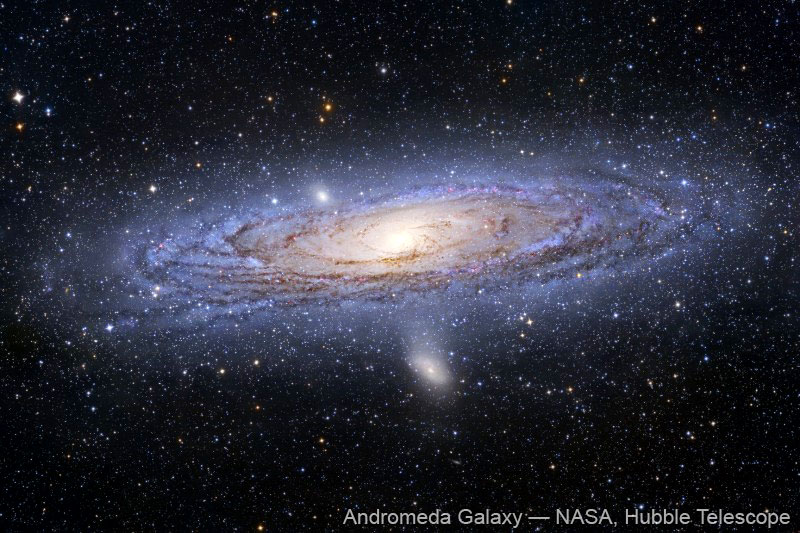
What do we know about The Andromeda Galaxy?
Well, this is The Andromeda Galaxy, the big brother of our galaxy family named Local Group. It is a spiral galaxy a little larger than our Milky Way Galaxy about 2.5 million light-years away. And it hosts about a trillion stars. You can get a whole bunch of other statistic data from the wikipedia. The Local Group is what I'm going to talk about. It consists of The Andrameda Galaxy, The Milky Way Galaxy and several dozens of smaller galaxies. These galaxies are bounded by gravitational pulls and orbiting the mass center of the Local Group. Well, the galaxies may not orbitting as you think as the planets orbitting the Sun. Because their orbits may not be circles or not even ellipses, but some weird trajectories. Sometimes they get closer, and sometimes they are faraway. Sometimes a smaller galaxy get ejected out to nowhere when several galaxies dance together. And sometimes two galaxies collide into each other when they get too close.
Does it have anything to do with us?
Sure it does, because The Andromeda Galaxy is moving towards us! The first time I realized that The Andromeda Galaxy was getting closer is the time when I watch the documentary series Wonders of the universe back in 2011. They said that The Andromeda Galaxy will 'meet' our galaxy in about 4 billion years from now, according to the sight-line speed infered from the doppler effect. While the side-way speed remains unknown so currently we are not sure whether it would be a near miss or a direct hit. Wow, 4 billions years? That's before the Sun could devour the Earth. In mid 2012, not long after i finished the series Wonders of the universe, a big news came out. Scientists have confirmed that the meeting of the two galaxies in 4 billion years is not a near miss, but a head-on collision. Scientists analyzed the data collected by Hobble Space Telescope of the pass several years and finally concluded that the side-way speed is relatively small compared to the sight-line speed. Sounds like the scientists have another problem to worry about. When the collision happens, the solar system are sure to be influented. There is a good chances that the Solar system getting farther out from center in the newly combined galaxy, or a smaller probability get ejected out even farther to the empty space of the universe.
Is it really a big deal?
When the two galaxies collide, billions of stars merge together to form a new elliptical galaxy. New stars will be borned, and shape of the galaxy will change dramatically. But, our Solar system as an individual will remain intact. The probability of two star colliding with each other is really small, because the distance between stars is way bigger than the size of themselves. So, the Sun will function as normal and the planets' orbits are not disturbed(if the Sun hasn't devoured them). The biggest change will be the view of the night sky. There won't be a Milky Way anymore, but another fantastic view. However, if we are ejected out from the galaxy, much fewer bright stars can we obeserve in the night sky.